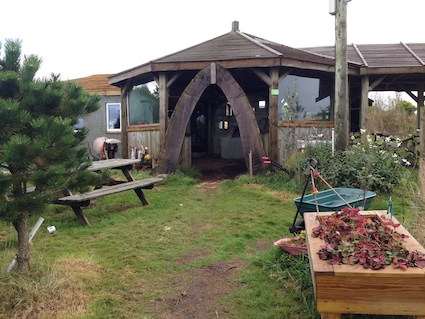
One commonly expressed concern about outdoor nurseries lies around the need for shelter and protection from the elements. Highway Farm is on a windy hill and this concern has been mitigated in several ways. First, the children are dressed for being outside. Second, there is a camp fire. Third, there are several large indoor spaces with wood burning stoves where packed lunches are eaten and children can explore. Next, over 1700 trees have been planted and these are proving effective at reducing wind flow through the space. Finally, there are lots of little sheds and shacks which provide shelter.
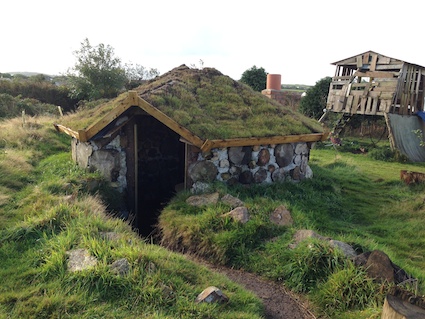
The sheds and shacks are an interesting facet of Highway Farm. They epitomise the child-centred and creative ethos of this unique outdoor nursery and out-of-school club. Essentially this post is a photo-fest of ideas and inspiration. If you haven’t read the previous Highway Farm blog posts, then it is well worth doing so here and here. There are lots of shacks and shelters already featured.
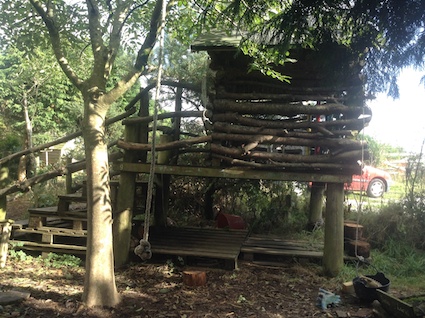
For me, this stick ‘n’ pallet shack sums up all that is special about Highway Farm. As you can see from the photos, the shack has been made by the staff and children. It has a good solid frame. So although the structure looks charmingly higgledy-piggledy, it’s robust enough to withstand high use from lots of children. You could even call this a good metaphor for any education approach – nothing beats a solid foundation upon which child-led approaches can flourish!
The pallets are used to raise the basement floor and to create steps. I love the use of cut green wood to create the sides of the shack. Green wood is wood which has been cut from a living tree. It is much stronger than sticks that have died and fallen off a tree – these have a tendency to snap.
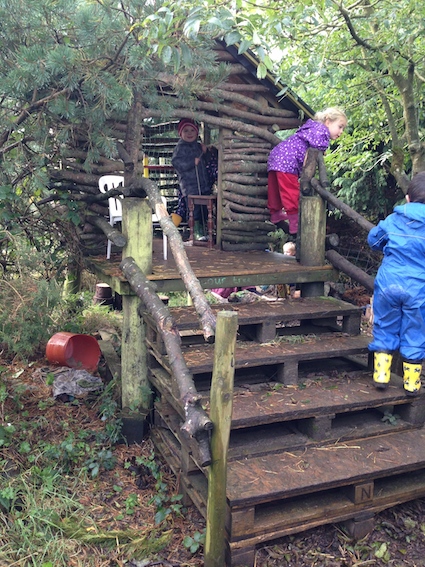
If you look carefully at the above photo, it is clear that the green wood can take the load of a child climbing on it. Also netting has been added in front of the horizontal sticks in the main den, which provides a little extra protection. I prefer this less-in-your-face approach to health and safety. By this I mean, that a lot of thought and care has been put into making the structure as safe as necessary but the measures are covert and don’t detract from the children’s play. They do not silently scream “danger!”
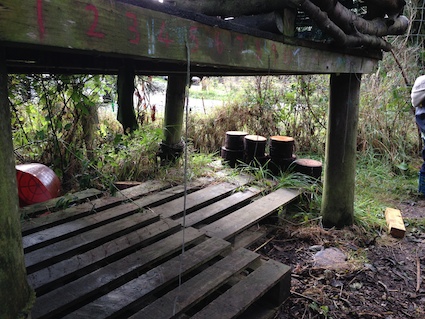
The two-tier structure with a basement which is big enough to play in, is another enticing addition. Look at the pile of stumps and availability of other loose parts for furthering the creative and imaginative play play possibilities. By providing a range of heights and levels, the children can see the world around them from a variety of different perspectives.
Below you can see more attention to detail. There is a cauldron on a pulley, allowing items to be transported vertically and facilitating more conversations between the two floors. I like seeing little touches like this where subtle additions facilitate cooperation and communication.
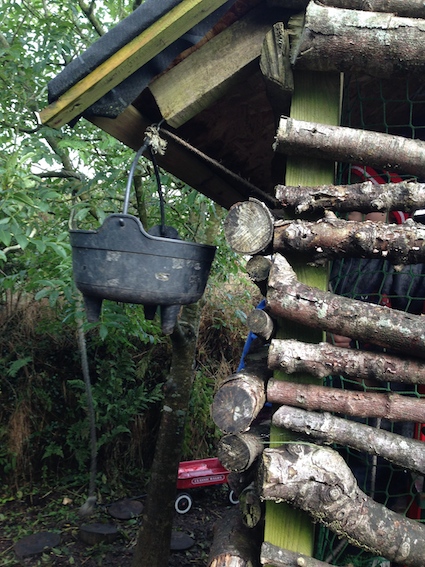
The ramshackle shelter featured below was created by the older children. Again, it may look like a rough affair, but it is full of surprises. For example, if a board comes loose, the children know to fix it. The windows and gaps in different places provide lots of lookout options. Underneath the structure you can see the beginnings of a digging pit.
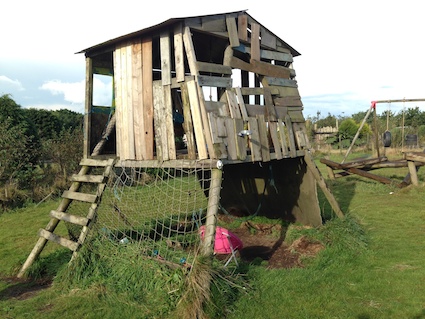
Having a choice of entrances and exits from a structure adds a touch of diversity. Hidden round the side of the building is a slide. A perfect alternative entrance and exit route. Just add water on a hot day to turn it into a water slide!

Children are also drawn to tiny places where they can be out of sight of an adult and feel they have privacy. It is worth spending time observing how children use little spaces so that you can work out what would appeal to children in your setting. On Highway Farm, one of the shelters is beautifully camouflaged.
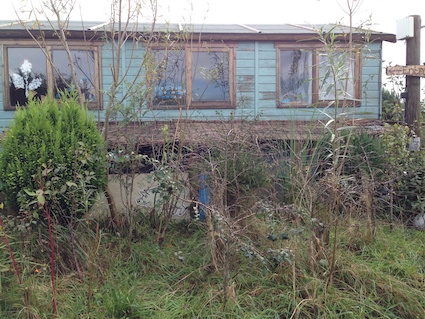
It is a long, narrow affair which runs along the side of the outdoor classroom. If you look closely there is an exit at the far end along with a recycled perspex circular window. The height of the boards is perfect for allowing children to hide yet also peek out over the top. It reminds me of a “human” hide for people watching!
As well as children being able to look out from structures, it also helps if children can look upon dens, nooks and crannies as well. By this I mean that they can watch other children use the structures and learn from their peers. Being able to copy another child at play or play alongside another child are important steps in the development of social skills.
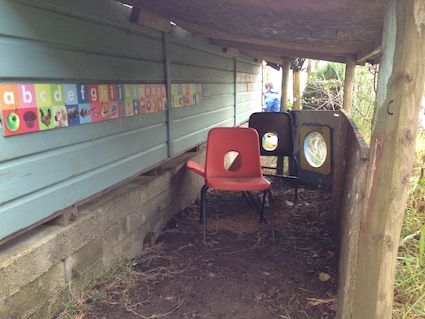
Children need opportunities to make their own spaces. Most settings facilitate this process through offering a variety of materials, fastenings and poles. But check out the use of the pallets and brashings below:
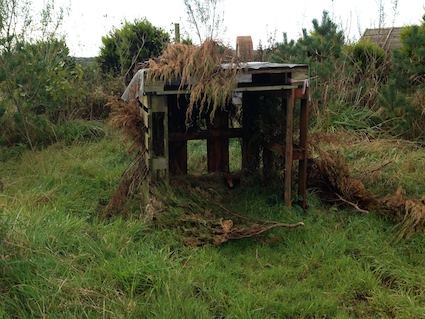
The staff add further support by facilitating children to turn such structures into more complex buildings. Concepts such as stability, centre of mass and load bearing are learned through trial and error and experimenting with real materials.
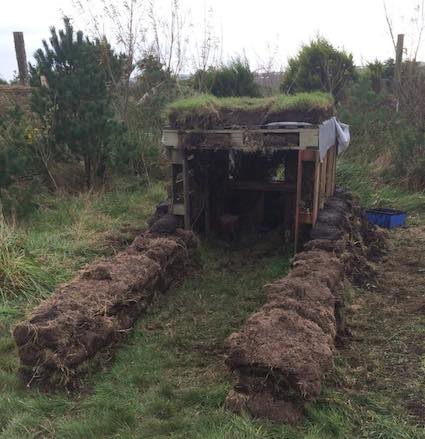
Multi-functional hiding spaces are always clever. The hide ‘n’ grow den below now features in the 2015 Cosy Catalogue, along with several other clever ideas from Highway Farm. As you can see, the roof is a raised bed and the sturdy legs provide a little cubby hole.
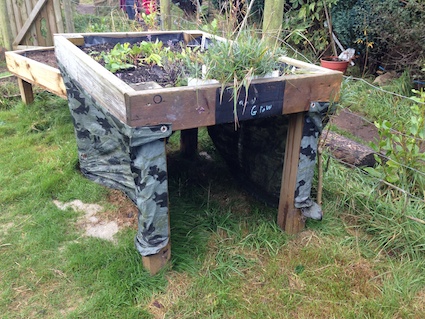
Children also develop a sense of space, volume and capacity by hiding away in a small shelter. Naturally small places that are just big enough for you and a friend or two, are extra special…
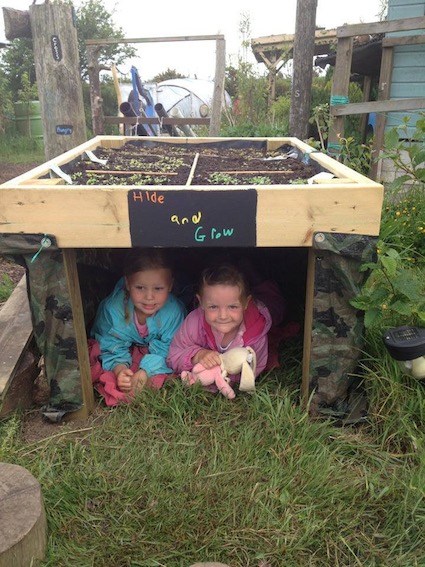
By providing lots of nooks and crannies, there is rarely overcrowding at any of them. The variety and range of places to visit and explore within the small outdoor space of Highway Farm is amazing. I’m certain, they play a large part in making the place feel much bigger than it actually is.
The Mud Cafe was another versatile play structure. Look at the use of netting as a functional permeable screen. This gives children inside a feeling of enclosure but enables children outside to look through and see what is happening. So it is a hook to come in and join the fun.
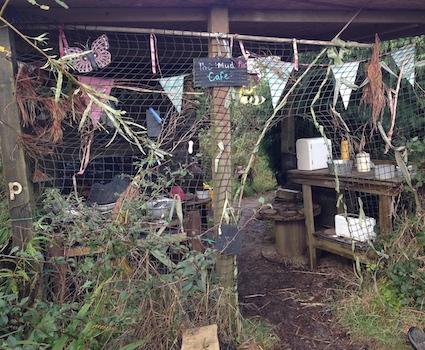
The spacious inside allows for a hodgepodge of kitchen items relating to capacity, size and other forms of measurement to be laid out attractively for children to use. Below, you can see that links to literacy are made through the use of blackboards as well as being a provocation for creating different a la carte offerings.

To one side, water is available. This enables children to transport the water into the Mud Cafe or elsewhere on site.

In the photo below, the children are busy playing in a quiet shelter. The previous year, a child had really needed a quiet place to be. So the staff and children had created this. Leading up to the shelter were signs requesting that everyone became quiet upon the approach. Even now, generally this area is still used for calmer activities.
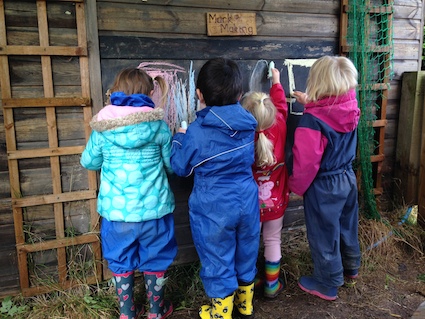
The use of netting and stock fencing enables children inside to look out and see what is happening. In particular, it is a place to watch the chickens in their deluxe 5-star hen house.
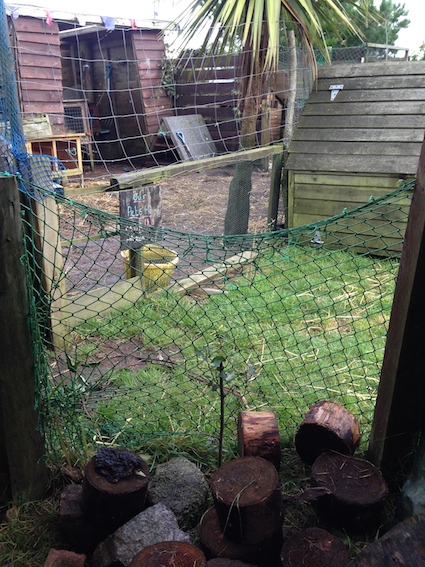
So, I hope the tour of Highway Farm through its versatile structures encourages you to reflect and think about how children are using you outdoor space. Many thanks once again to Martin Besford and the staff and children of the Little Explorers Outdoor Pre-school for making me welcome and answering all my queries.




















Thank-you once again for allowing lots of us a glimpse into this most inspiring setting. A brilliant post to start the new year with & I hope you’ll link it up to the Outdoor Play Party tomorrow too. Here’s to lots of more blogging adventures in 2015 & hopefully us meeting up again, Kierna
Thanks Kierna – I will add it to your Outdoor Play Party. And yes, it would be great to meet you again.
Wow. Just wow. I have seen all the bits and pieces in different posts, but this post is amazing. Highway Centre Farm has been on my “hope to visit” list but now, it has moved to my “must visit” list. Beautifully done.
Jessica – Highway Farm is particularly interesting. I think it challenges the traditional Early Years outdoor practice and therefore hopefully makes the sector stronger and more responsive to children’s needs. The outdoor education and play-based professional background of the staff certainly has brought a different approach and perspective.
Happy New Year Juliet. Of course your post does not get me thinking about how children are using the outdoor space, but how we provision our indoor spaces. Go figure. Through my trip through the UK, I began to see a stark difference between the indoor spaces and the outdoor spaces. Much like the shelters of the Highway Farm, the outside wild spaces and willow dens were calming compared with the all the indoor spaces that seem to shout color and distraction. When I was in a willow den, I could hear my own thoughts. In the classrooms, I felt like everything on the walls and shelves was screaming for my attention. Maybe we need to tone down our classrooms. Does that make sense?
Happy New Year Tom
Yes, your comments do make sense. Decluttering classrooms is a typical “outdoor” observation to make of “indoor” environments. 🙂